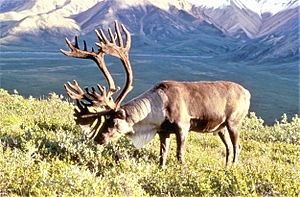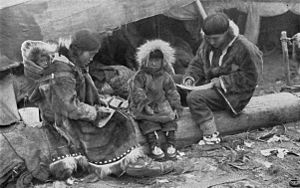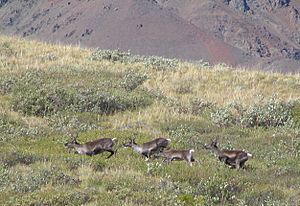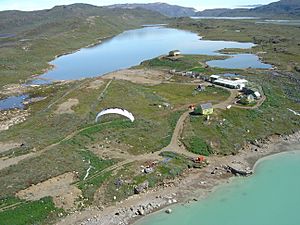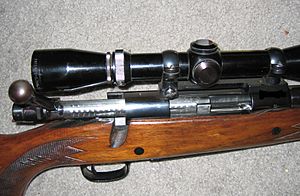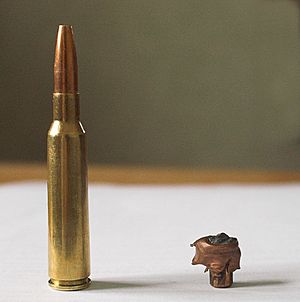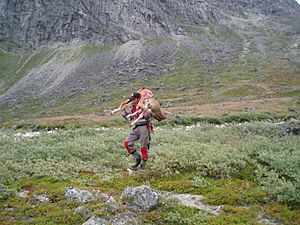Reindeer hunting in Greenland facts for kids
Reindeer hunting in Greenland is super important for the people living there, called the Greenlandic Inuit, and also for sports hunters, both locals and visitors. Reindeer, also known as caribou, are a key source of food. Hunting them has always been a big part of the history, culture, and traditions of the Greenlandic Inuit.
Hunting reindeer in a controlled way helps keep the animals healthy and ensures there's enough food for the Inuit. It also protects the tundra areas where reindeer eat. Scientists regularly study reindeer to figure out how many can be hunted. This helps keep nature in balance.
Contents
Why is Reindeer Hunting Important?
People have hunted wild reindeer for a very long time. In Greenland, the Inuit have always hunted them for food, clothes, shelter, and tools. They used methods like bows and arrows, snares, and even guiding reindeer into lakes to hunt them from kayaks. Today, hunters use modern firearms.
Every part of the reindeer is used. The meat, organs, and even stomach contents are eaten, either raw, dried, smoked, or cooked. The fur, skin, antlers, and bones are also used. Today, people mainly hunt reindeer for their meat. However, some hunters also seek older animals for their large antlers as trophies. Reindeer have the biggest antlers compared to their body size among all deer.
More reindeer are hunted in Greenland than any other large land animal. Reindeer meat is a main food for many families. People eagerly await the autumn hunting season. It's a chance to fill their kitchens and freezers with meat for the coming months. It's also an exciting adventure.
Hunting in Greenland can be tough because of the extreme weather. Greenland is a huge country with different hunting rules and weather patterns in each area. Hunters are expected to respect nature and "leave nothing but footprints."
Hunting and Inuit Culture
How Hunting Shapes Identity
Hunting has always been a huge part of the Greenlandic Inuit culture: "The Inuit culture is the most pure hunting culture in existence... Inuit are hunters, pure and simple." (Henriette Rasmussen, a Greenlandic Minister)
Even today, the Greenland government confirms how important hunting is: "Hunting is the heart and soul of Greenlandic culture... In a society like Greenland, which for centuries was based on hunting for survival, hunting is still very important culturally. Even though most people now work in modern jobs, many Greenlanders still feel deeply connected to hunting."
Reindeer hunting has a special place in people's hearts. Hunting a muskox gives four times more meat than a reindeer. But "Greenlanders would much rather have caribou or reindeer meat than musk ox meat," says Josefine Nymand.
Peter Nielsen, from the Ministry of Environment, explains: "... the experience is just as important [as the meat]. It is simply the most wonderful part of the year. The trips for the caribou hunt in the beautiful autumn weather have a great social and physical meaning for people's wellbeing. It has many functions."
Protecting Inuit Culture and Welfare
Humans and reindeer have depended on each other for a long time. It's important to keep this relationship strong for both their well-being. Reindeer hunting is so vital to some groups' culture that there's an effort to get it recognized on UNESCO's World Heritage List.
The Inuit's identity is closely linked to their land, history, and how they view hunting. For them, nature, hunting, and culture are all connected. When their hunting traditions are criticized, the Inuit see it as an attack on their way of life.
Inuit people are working to protect their culture and hunting traditions. They believe that campaigns against animal hunting ignore their values and threaten their way of life. Organizations like the Inuit Circumpolar Council are actively trying to protect their rights and culture.
Reindeer Health and Hunting Rules
Scientists watch the health of reindeer and their homes very closely. They suggest how many reindeer can be hunted to make sure there are enough animals and that nature stays balanced. Many things affect reindeer, like natural cycles, sickness, weather, and climate change. Hunting is one thing that can be controlled.
In southwestern Greenland, reindeer don't have natural predators like wolves. So, hunting limits are set to control their numbers. This stops them from eating too much food and starving. In winter, reindeer have to dig through snow to find their favorite food, a type of moss. This uses a lot of energy. Without human control, many reindeer would starve.
Hunting recommendations also depend on how many reindeer are in an area and if there's enough food. These numbers can change, so the rules are always updated. Historically, Greenland's reindeer population has changed a lot. For example, in the early 1970s, there were about 100,000 reindeer. By 1993, it was thought to be only 9,000. Because of these numbers, hunting was stopped from 1993 to 1995.
This stop in hunting made many people angry. Hunters believed there were more animals than the official numbers showed. A survey later proved the hunters were right. So, hunting limits were greatly increased, and the season was made longer.
In 2005, better counting methods showed that there were indeed too many reindeer. In 2006, the number was over 100,000. Too many reindeer can lead to more baby reindeer dying, damage to feeding areas, and a big drop in the population.
Scientists and hunters work together to help the reindeer, the hunters, and the sensitive tundra lands. Greenland's tundra is very delicate because of the nearby ice sheet, which makes plants grow slowly.
All About Reindeer
Reindeer (also called tuttu by the Greenlandic Inuit and rensdyr by Danes) are the only deer species where both males and females have antlers. Greenlandic reindeer can vary in size. Females can weigh up to 90 kg (198 lb), and males (bulls) up to 150 kg (331 lb). Both sexes can be hunted in Greenland.
Even though they have antlers, reindeer rarely use them against humans. Their main defense is to run away, often uphill. Males use their antlers to fight each other. Reindeer might use them to defend themselves and their young from predators like wolves, but wolves are not a threat in southwestern Greenland. While usually not aggressive towards humans, male reindeer in rut (mating season) might attack if a person gets between them and their group of females.
Tame reindeer can be curious. Even wild reindeer can be curious sometimes. Wild reindeer are shy and react quickly to sudden sounds, movements, or the smell of strangers. But young, inexperienced reindeer might even come close to a hunter out of curiosity. Reindeer have good hearing and a good sense of smell, but poor eyesight. They might react to a hunter's movements, but not necessarily to their shape if the hunter stays still. A quiet hunter can sometimes get surprisingly close to a reindeer. Many animals are shot from relatively close distances (10–50 meters).
Three Types of Reindeer in Greenland
Three types of reindeer live in western Greenland, and some have even mixed:
- The most common type is the native wild barren-ground caribou (Rangifer tarandus groenlandicus). This is a medium-sized reindeer also found in Canada.
- The second type is the wild mountain reindeer (Rangifer tarandus tarandus). These were brought from Norway in 1952. They are larger and were first released in the Kapisillit area. There's evidence that these Norwegian reindeer have mixed with the native caribou in some places.
- A third type might be the Peary caribou subspecies (Rangifer tarandus pearyi). These are smaller and fewer in number, living in northwestern Greenland.
Reindeer Hunting in Practice
How Hunters Prepare
Two main types of hunters harvest reindeer: licensed commercial hunters and private local sports hunters. Tourists, trophy hunters, and scientists also hunt a few animals.
Hunters usually travel to hunting areas by boat. Once there, they walk. If the hunting area is far inland, they might carry their gear to a lake. Then they cross the lake in a smaller boat like a rowboat or canoe. Some lakes have boats left there permanently, which hunters sometimes use.
In 2006, only bolt-action, non-automatic rifles using .222 Remington caliber cartridges or larger were allowed for reindeer hunting. A good, large rifle scope is important for long shots, especially when visibility is poor due to snow, fog, or low light. Folding or fixed-blade hunting knives are needed for many tasks. Binoculars with large lenses help spot animals from far away, even in dim light.
Other types of rifles, shotguns, and weapons can be used for other animals like ptarmigan, Arctic hares, and Arctic foxes, which hunters often see during a reindeer hunt.
Rules and Licenses
Hunting is controlled by rules and needs a license. This license states how many animals can be hunted. Hunters must also report their results after the hunt, often by providing a jawbone with teeth. Locals can get licenses after living in Greenland for two years. Special rules apply to tourists and trophy hunters. You can get information and licenses from the local government office.
Airplanes, helicopters, and other motorized vehicles like snowmobiles are not allowed for hunting or for transporting animals or hunters on land. Boats are allowed for travel to and from hunting areas. A special tag must be attached to the reindeer carcass until it is sold or used. The meat belongs to the hunter, and there are no extra fees for it.
In 2006, the hunting season was from August 10 to September 15. Sometimes these dates can change, for example, if there's bad weather or too much ice, the season might be extended. Winter hunting is an option for commercial hunters, who are usually Inuit residents.
Getting the Meat Ready
Once a reindeer is hunted, it's quickly cleaned by removing the internal organs. The skin, head, and organs are often left behind for foxes, ravens, and other birds to eat. The meat is kept cool to prevent spoilage and protected from flies with mesh bags. Any fly eggs or maggots are removed right away. The cool climate allows the meat to stay outside longer than in warmer places. This means a hunting trip can last several days without the meat losing quality. Once home, the meat can be hung and aged for a few days before being cut up.
Carrying a reindeer over long distances in hilly, rocky areas can be very hard work. Walking more than five kilometers each way is common. If the animal is very big, a hunter might only be able to carry half of it at a time. In Greenland, reindeer meat is often carried over the shoulders, or on the back with a headband, which is a method preferred by the Inuit. Unskinned animals can also be dragged on snow or slid down snowy hills, which saves a lot of effort.
Hunting Techniques
Hunters use different ways to find and hunt reindeer:
- Asking for advice: Getting tips from experienced reindeer hunters.
- Scouting: Looking for reindeer using different methods.
- Glassing: Using binoculars to spot animals from far away.
- Blind or stand hunting: Waiting where reindeer are likely to pass.
- Camouflage hunting: Hiding yourself to blend in with nature, like wearing a white jacket in the snow.
- Still hunting: Walking very quietly to search for animals.
- Stalking: Walking quietly to follow animals you've already seen.
- Tracking: Following clues like footprints to find animals.
- Drive hunting: Guiding reindeer towards other hunters.
Note: Using loose dogs, dog driving, and chasing animals with dogs are not allowed in Greenland.
Hunting Conditions in Greenland
A reindeer hunt can be a short afternoon trip or a week-long adventure requiring lots of gear. New hunters might feel a bit confused when they first enter the wilderness, and again when they return to civilization.
Reindeer hunting can be done in groups or alone. Hunting alone means taking extra safety steps. While hunting is usually fun, it can be tiring and has some risks. Good hygiene and staying hydrated can prevent sickness. A small first aid kit should always be carried when away from camp or the boat. Hunters should prepare for dangers like uneven, rocky, or muddy ground. Crossing streams and rivers can be risky due to slippery rocks. If there's snow and ice, there can be dangerous cornices (overhanging snow), crevasses (deep cracks), and avalanches. However, snow can also make it easier to spot and track reindeer.
The weather at the start of the autumn hunting season is often nice and mild. But it can change very quickly. Hunters might face fog, rain, wind, and even winter conditions. Sometimes, the weather can turn very bad with strong winds, storms, snow, hail, freezing rain, and blizzards, even in late summer. Not being prepared can have serious consequences.
Using a compass in Greenland is tricky because the magnetic north is very different from true north. If you don't calculate this correctly, you can get lost. Getting lost in bad weather wastes time and might force a hunter to spend a cold, wet night outdoors. Getting too cold (hypothermia) can make it hard to think clearly, making it even harder to find your way. Then, it becomes a fight for survival. Deaths are rare, but they do happen.



